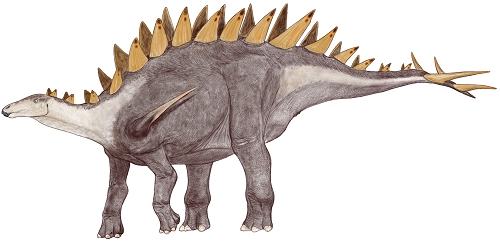Post by dinosauria101 on Jun 25, 2019 9:08:54 GMT 5
Yangchuanosaurus magnus
Yangchuanosaurus is an extinct genus of metriacanthosaurid theropod dinosaur that lived in China during the late Oxfordian (and possibly Kimmeridgian) stage of the Late Jurassic, and was similar in size and appearance to its North American contemporary, Allosaurus. It hails from the Upper Shaximiao Formation and was the largest predator in a landscape which included the sauropods Mamenchisaurus and Omeisaurus as well as the Stegosaurs Chialingosaurus, Tuojiangosaurus and Chungkingosaurus. The type specimen of Y. shangyouensis had a skull 82 cm (2.7 ft) long, and its total body length was estimated at about 8 m (26 ft). Another specimen, assigned to the new species Y. magnus, was even larger, with a skull length of 1.11 m (3.6 ft). It may have been up to 10.8 m (35.4 ft) long, and weighed as much as 3.4 metric tons (3.7 short tons). There was a bony knob on its nose and multiple hornlets and ridges, similar to Ceratosaurus. It had a massive tail that was about half its length.

Tuojiangosaurus multispinus
Tuojiangosaurus is a genus of stegosaurid dinosaur from the Late Jurassic Period, recovered from the Upper Shaximiao Formation of what is now Sichuan Province in China. Physically similar to the North American Stegosaurus, Tuojiangosaurus is the best understood of the Chinese stegosaurids. It was around 7 metres (23 ft) long and 2 metres (6.6 ft) high, with a postulated weight of around 4 tonnes (4.4 short tons). The type and only species, T. multispinus, was named in 1977 (exactly a hundred years after Stegosaurus) on the strength of two specimens, one over half complete. Like Kentrosaurus, Tuojiangosaurus had two rows of pointed plates along the spine, which became taller over the hip region. It also had two outward-pointing spikes on each side of the end of the tail, angled at approximately 45 degrees to the vertical. In stegosaurids, this spike arrangement has become affectionately known as the "thagomizer". It also had the typical narrow head, bulky body, and low teeth of other stegosaurids. Because it lacked the tall spines for muscle attachment found on the vertebrae of Stegosaurus, it was probably unable to rear up on its hind legs like that animal. This suggests that it would have eaten low-lying, ground vegetation.

Credit to Wikipedia
Yangchuanosaurus is an extinct genus of metriacanthosaurid theropod dinosaur that lived in China during the late Oxfordian (and possibly Kimmeridgian) stage of the Late Jurassic, and was similar in size and appearance to its North American contemporary, Allosaurus. It hails from the Upper Shaximiao Formation and was the largest predator in a landscape which included the sauropods Mamenchisaurus and Omeisaurus as well as the Stegosaurs Chialingosaurus, Tuojiangosaurus and Chungkingosaurus. The type specimen of Y. shangyouensis had a skull 82 cm (2.7 ft) long, and its total body length was estimated at about 8 m (26 ft). Another specimen, assigned to the new species Y. magnus, was even larger, with a skull length of 1.11 m (3.6 ft). It may have been up to 10.8 m (35.4 ft) long, and weighed as much as 3.4 metric tons (3.7 short tons). There was a bony knob on its nose and multiple hornlets and ridges, similar to Ceratosaurus. It had a massive tail that was about half its length.
Tuojiangosaurus multispinus
Tuojiangosaurus is a genus of stegosaurid dinosaur from the Late Jurassic Period, recovered from the Upper Shaximiao Formation of what is now Sichuan Province in China. Physically similar to the North American Stegosaurus, Tuojiangosaurus is the best understood of the Chinese stegosaurids. It was around 7 metres (23 ft) long and 2 metres (6.6 ft) high, with a postulated weight of around 4 tonnes (4.4 short tons). The type and only species, T. multispinus, was named in 1977 (exactly a hundred years after Stegosaurus) on the strength of two specimens, one over half complete. Like Kentrosaurus, Tuojiangosaurus had two rows of pointed plates along the spine, which became taller over the hip region. It also had two outward-pointing spikes on each side of the end of the tail, angled at approximately 45 degrees to the vertical. In stegosaurids, this spike arrangement has become affectionately known as the "thagomizer". It also had the typical narrow head, bulky body, and low teeth of other stegosaurids. Because it lacked the tall spines for muscle attachment found on the vertebrae of Stegosaurus, it was probably unable to rear up on its hind legs like that animal. This suggests that it would have eaten low-lying, ground vegetation.

Credit to Wikipedia


